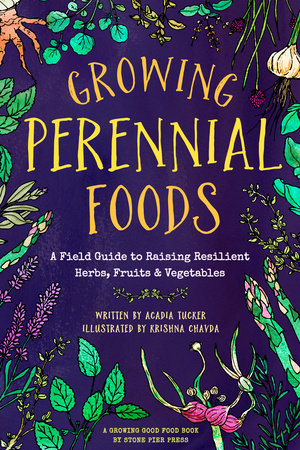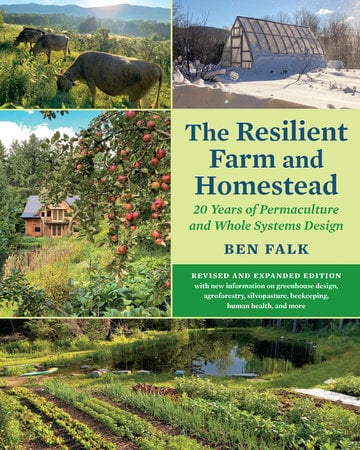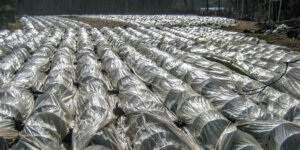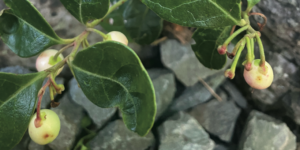Perennial Veggies: The Benefits of Perennial Vegetables
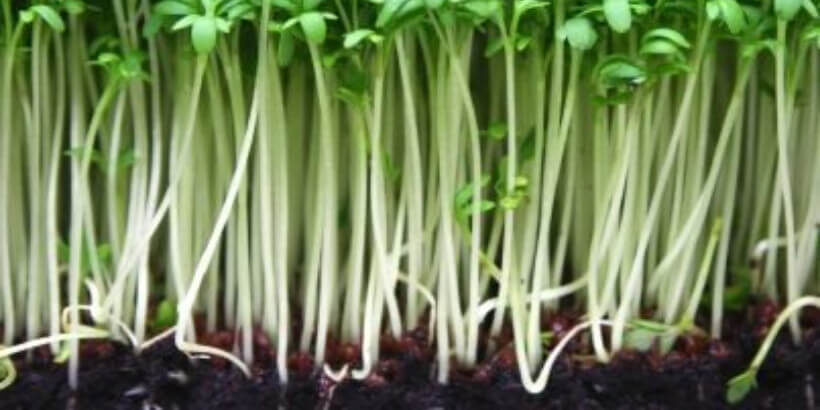
Think about how much work your perennial flower beds take compared to your annual vegetable garden. In a busy year, your perennial garden largely sails through despite neglect. Once your perennials are established, and if they are suited to your climate and site conditions, they can be virtually indestructible. An annual vegetable garden, as we all know, requires much more watering, weeding, and work to get a good crop.
Once established, perennial vegetables are often more resistant to the attacks of pests, due to their reserves of energy stored in their roots. Their deep roots and soil building abilities make them more self-sufficient in terms of watering, and their canopies which leaf out so much earlier than annuals better suppress the growth of weeds. What else can these remarkable plants do?
The following excerpt is from Perennial Vegetables by Eric Toensmeier. It has been adapted for the web.
Perennial vegetables are great soil builders
Perhaps the best ecological benefit from perennials is their beneficial effect on soil. Bare soil quickly dries out, and can be eroded by wind and rain, especially in sloping gardens. Tillage also kills many beneficial elements of the soil food web, particularly some of the best kinds of mycorrhizae (beneficial fungi that share nutrients with crop plants). Well-mulched perennials don’t need any tilling once they are established.
But the soil benefits of perennials are not just from an absence of tillage. Perennials improve organic matter, soil structure and porosity, and water holding capacity through the slow and steady decomposition of roots and leaves. Perennial vegetable gardens build soil the way nature intended—by allowing the plants to add more and more organic matter without tillage, and letting the worms do the work of mixing it all together.
Perennials provide ecosystem benefits
Perennials, especially trees, slow global warming by capturing atmospheric carbon dioxide. Trees also moderate microclimates, making the areas around them cooler and moister. Large numbers of trees can moderate the climates of whole regions in a similar fashion. The root systems of perennials catch and store water and nutrients that would otherwise be washed away. Perennials provide critical habitat to a number of animal, fungal, and other life forms, many of which are highly beneficial in gardens.
Perennial vegetables extend the harvest season
Perennials often have different seasons of availability than annuals, helping to spread the season of harvest throughout more of the year. While you are starting seeds indoors, and transplanting tiny vulnerable seedlings out to the garden (which must be watered and weeded frequently), perennials are already in robust growth and ready for harvesting. In my own garden I begin eating the first tender perennial shoots not long after the snow melts. Later, in the heat of mid-summer, I visit the sweltering hot beds along my driveway to harvest some delicious tropical heat-loving greens. Perennial vegetables can “pad out” those times of the year when your annual garden doesn’t have much to offer.
Perennial vegetables often can perform multiple functions in the garden
In addition to years or decades of low-maintenance yields, and soil building benefits, perennial vegetables can do other important jobs in the garden. Many are beautiful ornamental plants, offering the potential of attractive edible landscapes. Some species can function as hedges, groundcovers, or erosion control for steep slopes. Some provide free fertilizer for themselves and their neighbors by fixing nitrogen or accumulating subsoil nutrients. And some help out with pest control, by providing habitat or food for predatory and other beneficial insects. Vines like chayote and perennial cucumber can be grown over trellis frames to create “edible shadehouses” to snack in a cool place out of the sun.
Drawbacks of Perennial Vegetables
No crop is perfect, and perennial vegetables are no exception. Here are some of the disadvantages of growing perennial vegetables.
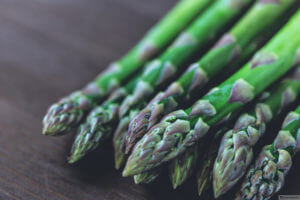 Some perennial vegetables are slow to establish, and may take several years to begin yielding well. Asparagus is a classic example.
Some perennial vegetables are slow to establish, and may take several years to begin yielding well. Asparagus is a classic example.
Like annual crops, some perennial greens become bitter once they flower. Thus their greens are available only early in the season. Perennial vegetables are not meant to replace annuals, but to complement them. In this case, perennial greens are available early in the season, providing greens until the annuals are up and running.
Many of the minor perennial vegetables have rather strong flavors, especially those adapted to cold climates.
Many perennial vegetables are so low-maintenance that they can become weeds in your garden, or escape and naturalize in your neighborhood.
Perennial vegetables will also not fit into your ordinary annual garden management plan, and will need an area to be set aside for them (just like you probably do now for asparagus, globe artichokes, or rhubarb).
Perennials have special disease challenges. First, you can’t use crop rotation to minimize diseases. Second, once they have a disease, they often have it for good—for example, plant viruses are problematic with some vegetatively-propagated perennial crops.
A note on “perennials grown as annuals”
One occasionally sees a crop described as a “perennial grown as an annual” (some of these crops re referred to here as “plant/replant perennials”). Sometimes there are good reasons to grow perennials as annuals. For example, if left in the same place year after year, potatoes would build up terrible disease pressure. On the other hand, many crops usually grown as annuals make fine perennials (such as skirret, which actually has better flavor when grown as a perennial).
In some cases, we just don’t know what would happen to these crops if they were allowed to persist for multiple years. Perhaps new techniques would need to be developed to manage them in this fashion. It is my hope that readers of Perennial Vegetables what happens.
Why you’ve probably never heard of them before
Why are asparagus, rhubarb, and globe artichokes the only perennial vegetables most gardeners have heard of? I have a few practical answers, and some speculative ones addressed in the accompanying article.
Lack of information
When I first became interested in perennial vegetables, I found that I had to fish for little bits of information here and there. There was no single book or website devoted to perennial vegetables. One could read many gardening books, review issues of garden magazines, and never get an inkling that this other class of vegetable crops even existed. My sincere hope is that the publication of this book will help to rectify the situation.
The chicken-and-the-egg problem
Only a small number of nurseries and seed companies offer even the best perennial vegetables – some are still commercially unavailable in the U.S. and Canada as I am writing. These plants will never have the chance to become popular if no one can acquire them. On the other hand, nurseries and seed companies will never offer them if there is no demand.
Readers of Perennial Vegetables can break us out of this cycle by requesting (nay, demanding!) perennial vegetables from your favorite companies. With your help, these useful and delicious plants will soon be widely known and grown.
The Origins of Annual Agriculture in North America
In the United States and Canada, most of our gardening traditions come from Europe, where there are few perennial crops (except fruits and nuts). But much of our land mass is well suited to crops from warm and tropical regions—where, it turns out, there are numerous perennial vegetables.
But why haven’t people been growing perennial vegetables in the United States and Canada for centuries? In the tropics there are many more perennial vegetables. Why were so few perennials domesticated in colder and temperate climates? The answer may have its roots in the multiple independent origins of agriculture itself, and the historical peculiarities of the areas where crops were domesticated.
In tropical areas of Africa, Asia, and Latin America, agriculture developed strongly around root and starchy fruit crops as staples. This enabled crops to be grown in mixtures of trees, vines, perennials, and annuals. Cold and temperate Eurasian agriculture was built around annual grains and legumes. Why did this happen? Partly it is a question of the plants available as raw material for domestication—perhaps, with a far greater diversity to choose from, more perennial candidates were available in the tropics.
But, remarkably, Europeans actually took some perennial wild edible plants and bred them into annual crops, such as beets and brassicas. In contrast, ancient Andean people domesticated the perennial, rather than annual, forms of arracacha. In fact, a strikingly high number of perennial vegetables originated in the tropical Americas, like chayote, chaya, and perennial beans.
One possible explanation is that the Americas were without domesticated draft animals to pull plows. All farm work had to be done with hand tools, allowing different parts of the farm to get custom treatment with no real extra energy cost. In most of the Old World, draft animals were used to plow up large areas. Growing perennials would have required areas set aside for different management systems. Perhaps this explains the “annualizing” of perennial wild crops like beets and brassicas.
Jared Diamond’s book Guns, Germs and Steel offers an intriguing history of agriculture. It turns out that agriculture in Eurasia began in the Mediterranean, in a winter rain-summer drought climate that favored annuals. These crops were adopted in Europe, and may have superseded any development of perennials that might have otherwise occurred.
Another factor could be that early crop domesticators’ most important goal was getting enough food to eat. Perhaps raw material from annuals gave quicker rewards than perennials, particularly in cold climates where a short season often requires several years for perennials to begin bearing.
Whatever the origin of our neglect, there is certainly no longer a valid reason to ignore these useful and productive crops. They can be made much more widely available, and I believe that a network of gardeners will prove them to be an important new component of food production in the United States and Canada in the coming years.
Recommended Reads
Recent Articles
These snacks might be too darn cute to take a bite of! Brighten up snack time this winter using fruits and veggies we all know and love.
Read MoreWant to grow year-round, but a greenhouse feels like a big investment? When it comes to cost and flexibility, low tunnels are the all-around winners.
Read MoreWintergreen is the stunning evergreen groundcover that’s a game-changer for your garden! It’s cherished for its aromatic leaves, vibrant fall color & bright berries.
Read More



